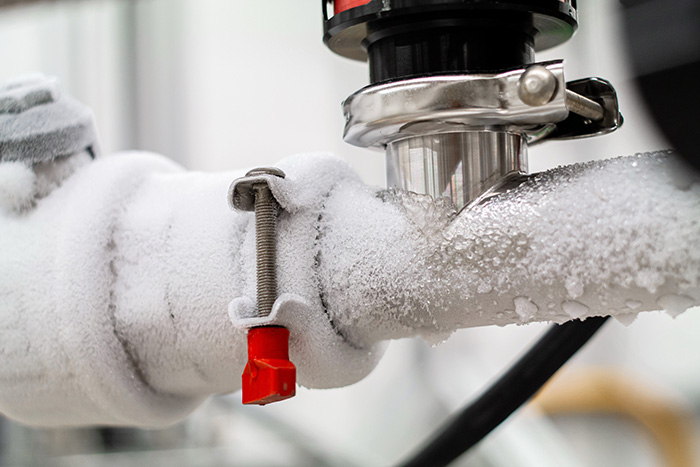How to Protect Plumbing System from Cold Weather: Essential Strategies
How to Protect Plumbing System from Cold Weather: Essential Strategies
Blog Article
Nearly everybody will have their own unique conception on the subject of How to prepare your home plumbing for winter weather.
:strip_icc()/snow-outdoor-faucet-pipes-4af65d1e5e904fb1aa7bf74071fe5d89.jpg)
Winter can damage your pipes, particularly by freezing pipelines. Right here's how to avoid it from taking place and what to do if it does.
Intro
As temperatures drop, the danger of frozen pipelines increases, possibly resulting in pricey fixings and water damages. Understanding how to avoid icy pipelines is important for property owners in cool environments.
Avoidance Tips
Shielding at risk pipes
Cover pipelines in insulation sleeves or utilize warmth tape to secure them from freezing temperature levels. Focus on pipelines in unheated or exterior locations of the home.
Home heating methods
Maintain indoor spaces appropriately heated, particularly locations with plumbing. Open cupboard doors to permit cozy air to circulate around pipes under sinks.
Exactly how to recognize icy pipelines
Look for decreased water flow from faucets, unusual odors or noises from pipes, and visible frost on exposed pipes.
Long-Term Solutions
Architectural adjustments
Take into consideration rerouting pipes away from exterior walls or unheated locations. Add additional insulation to attic rooms, basements, and crawl spaces.
Upgrading insulation
Purchase premium insulation for pipelines, attics, and wall surfaces. Correct insulation helps preserve constant temperature levels and lowers the threat of icy pipes.
Safeguarding Outside Pipes
Yard hoses and outdoor taps
Disconnect and drain garden hoses prior to winter season. Mount frost-proof faucets or cover outdoor taps with shielded caps.
Recognizing Frozen Pipelines
What triggers pipes to freeze?
Pipelines ice up when subjected to temperatures listed below 32 ° F (0 ° C) for extended durations. As water inside the pipelines ices up, it expands, taxing the pipeline wall surfaces and possibly causing them to rupture.
Risks and damages
Frozen pipelines can result in water disruptions, residential or commercial property damage, and expensive repairs. Burst pipes can flood homes and cause extensive architectural damage.
Signs of Frozen Pipeline
Recognizing frozen pipes early can avoid them from rupturing.
What to Do If Your Pipelines Freeze
Immediate activities to take
If you think frozen pipelines, keep faucets open up to relieve stress as the ice thaws. Utilize a hairdryer or towels taken in hot water to thaw pipes slowly.
Final thought
Stopping frozen pipelines needs proactive actions and quick feedbacks. By recognizing the causes, indications, and safety nets, homeowners can protect their plumbing throughout winter.
6 Proven Ways to Prevent Frozen Pipes and Protect Your Home
Disconnect and Drain Garden Hoses
Before winter arrives, start by disconnecting your garden hoses and draining any remaining water. Close the shut-off valves that supply outdoor hose bibs and leave the outdoor faucet open to allow any residual water to drain. For extra protection, consider using faucet covers throughout the colder months. It’s also important to drain water from any sprinkler supply lines following the manufacturer’s directions.
Insulate Exposed Pipes
Insulating your pipes is an effective way to prevent freezing. Pipe insulation is readily available at home improvement stores and is relatively inexpensive. Pay close attention to pipes in unheated areas such as the attic, basement, crawl spaces, or garage. Apply foam insulation generously to create a buffer against the cold. You can also wrap your pipes in heat tape or thermostat-controlled heat cables for added warmth.
Seal Air Leaks
Inspect your home for any cracks or openings that could let in cold air. Seal any holes around the piping in interior or exterior walls, as well as the sill plates where your home rests on its foundation. Additionally, make sure to keep your garage door closed unless you’re entering or exiting. Leaving it open creates a significant air leak that can lead to frozen pipes.
Allow Warm Air Circulation
During cold snaps, it’s essential to allow warm air to circulate evenly throughout your home. Leave interior doors ajar to promote better airflow. Open kitchen and bathroom cabinets to help distribute heat consistently around the rooms. If you have small children or pets, be sure to remove any household chemicals or potentially harmful cleaners from open cabinets for safety.
Let Faucets Drip
A small trickle of water can make a big difference in preventing ice formation inside your pipes. When temperatures drop significantly, start a drip of water from all faucets served by exposed pipes. This continuous flow helps prevent the water from freezing. Additionally, running a few faucets slightly can relieve pressure inside the pipes, reducing the chances of a rupture if the water inside does freeze.
https://choateshvac.com/6-proven-ways-to-prevent-frozen-pipes-and-protect-your-home/

I stumbled upon that post about How to Prevent Your Pipes From Freezing when doing a lookup on the web. In case you enjoyed our blog posting if you please don't forget to share it. Thanks so much for going through it.
Recurring Service Plans Report this page